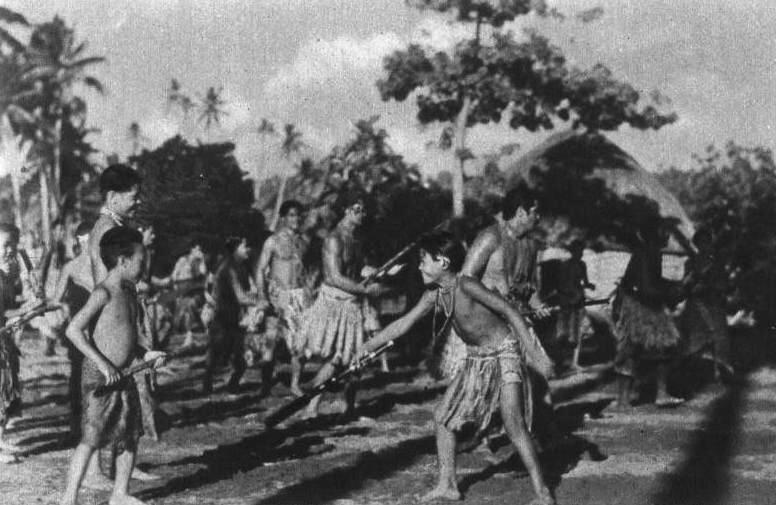
Samoan Islands History: New Zealand Mandate (1920-46)

Figure 1.--Samoa until World War II andctge carrival of the Americans was still largely traditional. Here Safune boys are playing at war. Safune is a traditional village district on the central north coast of Savai'i island. This same scene might have taken place centuries erlier.
|
|
New Zealand administered the island under a League of Nations Class-C Mandate. An estimated quarter of the Samoan population perished in the dreadful influenza epidemic (1919-19). The ensuing Royal Commission of Inquiry into the Epidemic concluded that New Zealand authiriries contributed to the epidemic. there was no epidemic of pneumonic influenza in Western Samoa before the arrival of the SS Talune from Auckland (November 7, 1918). Authorities allowed it to berth in violation of quarantine regulations. Within 7 days influenza had become epidemic in Upolu and proceeded to spread rapidly throughout the ilands. The population had little resistance to the virus. This of course was only the local manifestatiin of tge world-wide flu epidemic. A New Zealand civil administration replaced the World War I military government (May 1920). The New Zealand mandate was confirmed by the League of Nations Council (December 1920). A New Zealand Administrator was appointed, charged with the executive government of the island. An advisory Legislative Council consisting of six official, four Samoan, and two elected European members was established. Two “fautua” (official Samoan advisors, representatives of the traditional high chiefly lines of Samoa) and a “Fono of Faipule”, a body of 41 Samoan district representatives, also acted as advisers to the Administrator. This was the first move toward self government. The 'Mau' resistance movement developed (1926). Iy actually had origins dating back tobthe German occupation era. It was a civil disobedience effort to resist New Zealand control. A major issue was discontent over the loss of certain high titles. It was a kind of unofficial opposition to the New Zealand Administration. The strength of the Mau varied over time. We note one source suggesting that it achieved wide-spread support because of 'New Zealand mistreatment of the Smoan people'. The source does not explain just how the Samoans were mistreated and we are still looking intob this. There does seem to have been excesive firce used to confrint the Mau. We are unsure, howver, aboutvother aspects of New Zealand rule. The Mau did not develop as a Samoan Nationalist movement. It was more a factional development as there was as much factional animosity as resistance to the New Zealanders. The movement gradually disapated (1936).
HBC

Navigate the Boys' Historical Clothing Web Site:
[Return to the Main Samoan history page]
[Return to the Main Samoan page]
[Return to the Main Oceania country history page]
[Introduction]
[Activities]
[Biographies]
[Chronology]
[Cloth and textiles]
[Clothing styles]
[Countries]
[Topics]
[Bibliographies]
[Contributions]
[FAQs]
[Glossaries]
[Images]
[Images]
[Links]
[Registration]
[Tools]
[Boys' Clothing Home]
Created: 3:27 AM 1/23/2012
Last updated: 1:36 AM 5/29/2012



